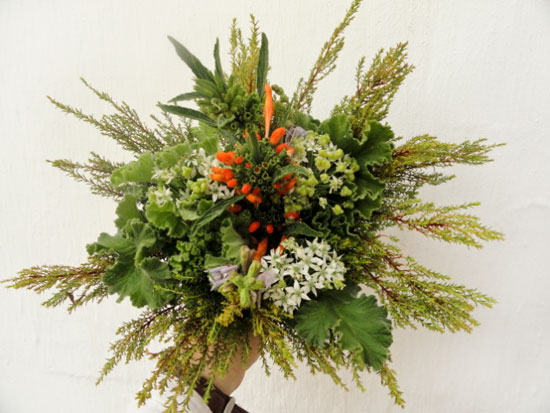Inspirations from a foodie, artist and landscaper: a tussie-mussie garden

If you missed it—and I’m not sure how you did, since it seemed to be everywhere—there was a Royal Wedding last month. Whatever your personal issues with the Royal I Do’s, there was a repeated theme that I found quite intriguing—trees and flowers and their folkloric meanings. All the flowers in the royal bridal bouquet had a symbolic meaning to the royal family, Middleton family, as well as conventional knowledge.
We all have heard that red roses are a message of love, yellow roses a note of friendship, etc. I personally am a Jane Austen fan. I often have visions of being an Emma or Elisabeth, taking a turn in the garden, collecting a nose-gay of forget-me-nots on my way to town, hoping to conjure true love. I find the concept fascinating, and mourn the loss of the subtleness of the custom.
I understand the difficulties in the practice of carrying flowers in these times (I can just see a clients face as I enter the conference room holding a briefcase, a set of plans and a tiny bouquet of larkspur and calendula—oh my!). But it would be lovely to set aside a tiny area of your yard to a dedicated tussie-mussie garden. The language of flowers is a time-honored tradition dating back to the sixteenth century and can be incorporated easily into your landscaping.
Plants that are common in a Tussie-Mussie Garden
A classic Tussie-Mussie garden includes:
- Hybrid Tea Rose
- Thyme
- Lavender
- Chamomile
- Mint
- Feverfew
- Coreopsis
- Pansy
- Blackeyed Susan
- Daisy
- Nigella
- Geranium
This display conveys protection, cheerfulness, comfort, hidden loves and united family.
Mint Sauce over Roasted Lamb
Small bunch of mint
2 tsp sugar
1 tbsp boiling water
1-2 tbsp vinegar
Place the mint and sugar on a board and chop finely. Put in a sauceboat and add the boiling water. Stir until the sugar has dissolved. Stir in the vinegar to taste.
Tussie-Mussie in a Teacup
Keep your beautiful tussie-mussie garden all year by drying a few flowers and arranging them in an old castoff china teacup filled with floral foam. You will need your dried flowers, small amount of green sheet moss (to cover your foam) a knife, scissors, floral pins and glue. Remember, a nose-gay is meant to be diminutive so keep it simple and sweet. Fit the foam to your cup and cove with a thin sheet of moss. Put your largest flower in the center, and arrange the smaller ones throughout.
Thank yous to Ellen Dugan and Gillian Haslam for ideas and plant meanings.


